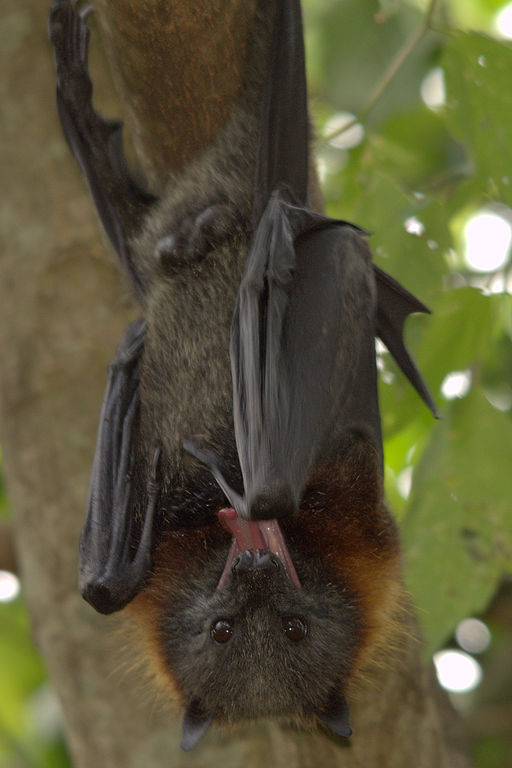 Flying-foxes (commonly referred to as fruit bats or bats) and all other types of bats are native species protected under the Nature Conservation Act 1992. It is an offence to kill or injure them, or to interfere with their roosts.
Flying-foxes (commonly referred to as fruit bats or bats) and all other types of bats are native species protected under the Nature Conservation Act 1992. It is an offence to kill or injure them, or to interfere with their roosts.
Three species of flying-fox seasonally visit the region: Black Flying-fox, Grey-headed Flying-fox and Little Red Flying-fox. The animals occupy three roosts:
- Dalrymple Park, Allora
- McCahon Bridge Park, Warwick
- Gleeson Park, Stanthorpe
The roosts are typically occupied between October and April. However, recent years have seen low numbers of flying-foxes over wintering in Allora and Stanthorpe. The roost sites are monitored by Council officers while the flying-foxes are in residence. Officers collect data on the species, numbers, the presence of dependent young and any breeding activity. This information is important for understanding flying-fox behavior in the region and, when roost management activities are deem necessary, influences the type and extent of management activities to be undertaken.
If flying-foxes are located on private property, landholders can access information on appropriate management options from the Queensland Government.
If flying-foxes are located on Council land and are impacting on the health and well being of the community or causing damage, please contact council (1300 MY SDRC). Council officers will assess the situation and may decide to take some roost management action. Council is required to notify the Department of Environment and Science at least 48 hours prior to undertaking roost management activities. Any management actions will be in accordance with the Code of practice - Ecologically sustainable management of flying-fox roosts. Dispersal of a flying-fox roost is seldom successful and in many cases actually makes the situation worse as such dispersal of a flying-fox roost will only be considered as a last option.
Flying-fox Management Plan
Council has adopted a Flying-fox Management Plan (PDF 5.8MB) for the region. The plan was developed with funding support from the Queensland Government’s Local Government Flying-Fox Roost Management Grants Program.
Flying-fox Safety Issues
Flying-foxes can be hosts to a number of bacteria and viruses which can be harmful to humans, however they usually avoid contact with people. Scratches or bites occur more commonly if the animal is being handled. Although the risk of infection is low, members of the public should not handle bats or flying-foxes. Further information on flying-foxes and human health can be obtained from Queensland Health.
Sick or Injured Flying-fox
If you find a sick, injured or orphaned bat, do not touch it. Contact the RSPCA (1300 ANIMAL or 1300 264 625) or your local wildlife caregroup/rescuer/carer, or the Department of Environment (1300 130 372) for assistance.
If you suspect Hendra Virus cases are affecting horses on a property, contact your vet immediately and Biosecurity Queensland on 13 25 23. Do not have close contact (body fluids) with sick horses without wearing adequate protective clothing.
If residents have concerns about bats or flying foxes located close to where they live, the DEHP Fact Sheet- Advice on Living Near Flying Foxes (link below) can be provided.
Disposal
Council is not able to collect injured or dead flying-foxes from private property. If a you have found an injured or dead flying-fox, please refer to information above.
If a dead flying-fox is reported on Council land, the request will be treated the same as other animal carcasses and Council will organise its removal.
Please refer to the Council's waste facilities website for information on where dead animals are accepted.
Useful links: